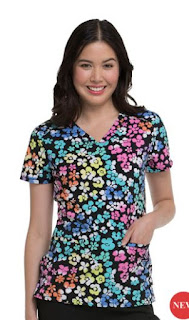The History of Medical Uniforms
By Jordie Papa
 |
| Image by Uniform Destination |
When it comes to modern medical uniforms, drab is out
and color is in. Today’s medical workers
can choose from a wide variety of colors and style, including patterned tops
and customized trim that makes scrubs and lab coats a fashion statements. But what most people who work in the medical
profession today forget is medical uniforms were not always this way. Go back fifty to a hundred and fifty years
and you would be surprised and even shocked by what doctors and nurses were
required to wear. For the sake of
nostalgia, as well as to give those who labor in the profession today an
appreciation for how much better they now have it, I thought I would dedicate
today’s blog to reliving a blast from the medical past.
When
Function Trumped Form
Go back just a couple of generations and typical
hospital garb was plain Jane, with doctors sporting white lab coats and nurses
required to dress from head to toe in white. We’re talking white frock, cap, socks
and shoes. It’s enough to make you squint, these outfits were so bright. The white on white nursing uniforms of the
era were a holdover from the period immediately following First World War.
Before World War I, nurse uniforms and nun’s habits
weren’t all that different, since nuns back then used to routinely serve as
nurses and it wasn’t unusual during that era for nurses to become nuns who
served the medical profession. While nurse’s dresses of this period were
tailored to provide utility by including such touches as pockets, the outfit
customarily included an apron, which made nurse outfits look a lot like maids.
Medical
Practitioner or Servant?
 |
| Image courtesy of wikimedia |
During the 19th Century, nurses did in fact
wear servant’s uniforms, which at the time were full-length black gowns. During
this era, nurses were considered little more than handmaidens to physicians and
surgeons alike. It wasn’t uncommon back
then for wealthy households to have a nurse on staff, right along with the
butler, maid and gardener. It wasn’t until the middle of the century that the
nursing profession gained a little more respect.
With their new stature also came new attire. Instead
of wearing servants garb, nurses wore more formal gowns with white aprons and
caps, denoting their profession. Even
nursing students of the era sported distinctive hats and ribbons to denote
their station. Student nurses typically wore pink or blue ribbons, while more
senior students wore black ribbons.
Doctor’s of the era also dressed all in black. This
was done to indicate the solemn nature of the profession. Back then, the only
people who wore white lab coats were researchers who toiled in laboratories.
The problem was, undertakers of the era also wore black suits. This resulted in a bit of a PR problem, which
was resolved by having physicians switch to white coats at the end of the 19th
Century.
The
Nurse Corps
By the time of the Civil War, while nurses still wore
no gloves or masks, they began to wear white, including full-length white gowns
and aprons. This was also the period where the armbands with red crosses were
first used to identify healthcare workers. The ironic thing was, long sleeved,
full-length gowns and aprons worn by nurses of the era were supposedly designed
with the intent of warding off infection.
It wasn’t until more than a hundred years later that it was learned that
these outfits were more likely to transmit contagion than to prevent it.
 |
| Image courtesy of wikimedia |
By World War I, more than 20,000 nurses were assigned
to active duty with the Army, Navy, and the Red Cross Overseas Service. Shortly after the war, the ranks of nurses
swelled during the Influenza pandemic that killed more than 25 million
worldwide. It was during this time that
latex gloves were first developed by surgeon William Halstead. The story behind their development is almost
as interesting as the effect they had on public health. Halstead’s gloves weren’t created with the
intent of slowing the spread of communicable disease. He invented them because his fiance,
Caroline, had developed a severe rash caused by the chemicals then used to
disinfect hands. Soon, other medical
professionals began wearing latex gloves which dramatically reduced the spread
of infection. The next time you pull on
a pair of latex gloves you can thank a smitten surgeon with their creation.
During World War II, nearly 60,000 nurses were pressed
into duty with the Army Nurse Corps. This was also the war that saw nurses
working closer to the front lines than ever before. Soon nurses had to deal
with being under fire as they labored in field hospitals, on ships, or in
medical transport planes. The effect of having skilled nurses so close to the
front saw a dramatic reduction in combat mortality. Less than 4% of all soldiers who received
care in the field died from their wounds or subsequent infection.
MASH
was More than a Movie
The Korean War saw the development of Mobile Army
Surgical Hospitals, otherwise known as MASH units. Having doctors and nurses so
close to the battlefield saw a 50% reduction in battle-related death than those
of the Second World War. These units
were so close to the action that both doctors and nurses dressed mainly in
olive drab, only donning mask, gown and gloves whenever they ventured into the
ER. While the Robert Altman film of 1970
and the subsequent TV series turned MASH into a hit comedy viewed by millions,
those assigned to these front-line units thought their stint there was anything
but a laughing matter.
 |
| Image courtesy of Profiles in Science |
While the Korean War had MASH, the same units deployed
during the Vietnam War were called MUST for Medical Unit Self-contained
Transportable. Like the MASH units that
preceded them, MUST units were designed with one purpose in mind: saving
lives. Unlike their Korean War
predecessor, MUST units were far better equipped, containing their own
radiology, pharmacy and dental departments within the unit itself. They were also far more mobile since there were
no fixed front lines in Vietnam.
MASH was back during the Iraq War with the 212th
Mobile Army Surgical Hospital located in An Najaf. Since this was a desert war, the doctors and
nurses assigned there traded in their khakis for what was colloquially referred
to as coffee-stain camouflage. Featuring
a 3-color mottled pattern of beige, dark brown and pale green, the US
military’s Battle Dress Uniform was designed in the 1990’s to blend into any
sandy environment.
Who knows what kind of garb the doctors and nurses of
any future conflict will wear when they serve their country. If the President’s proposed sixth branch of
the military known as the US Space Force becomes a reality, will medical personnel
assigned there be required to wear black and white? Who knows.
All we can be sure of is when it comes to keeping up with the times,
medical uniforms will always keep pace with the future.
Jordie Papa is owner of Uniform Destination with four locations in North Florida.

Medical uniforms have come a long way, baby! Scrubs beat those tents nursed wore a hundred years ago.
ReplyDeleteVery interesting, it all makes sense.
ReplyDeleteadu jago laga ayam bangkok
ReplyDeleteIrrespective of receiving daily oral or future injectable depot therapies, these require health care visits for medication and monitoring of safety and response. If patients are treated early enough, before a lot of immune system damage has occurred, life expectancy is close to normal, as long as they remain on successful treatment. However, when patients stop therapy, virus rebounds to high levels in most patients, sometimes associated with severe illness because i have gone through this and even an increased risk of death. The aim of “cure”is ongoing but i still do believe my government made millions of ARV drugs instead of finding a cure. for ongoing therapy and monitoring. ARV alone cannot cure HIV as among the cells that are infected are very long-living CD4 memory cells and possibly other cells that act as long-term reservoirs. HIV can hide in these cells without being detected by the body’s immune system. Therefore even when ART completely blocks subsequent rounds of infection of cells, reservoirs that have been infected before therapy initiation persist and from these reservoirs HIV rebounds if therapy is stopped. “Cure” could either mean an eradication cure, which means to completely rid the body of reservoir virus or a functional HIV cure, where HIV may remain in reservoir cells but rebound to high levels is prevented after therapy interruption.Dr Itua Herbal Medicine makes me believes there is a hope for people suffering from,Parkinson's disease,Schizophrenia,Lung Cancer,Breast Cancer,Colo-Rectal Cancer,Blood Cancer,Prostate Cancer,Scoliosis,Fibromyalgia,Fluoroquinolone Toxicity
ReplyDeleteSyndrome Fibrodysplasia Ossificans Progressiva.Fatal Familial Insomnia Factor V Leiden Mutation ,Epilepsy Dupuytren's disease,Desmoplastic small-round-cell tumor Diabetes ,Coeliac disease,Creutzfeldt–Jakob disease,Cerebral Amyloid Angiopathy, Ataxia,Arthritis,Amyotrophic Lateral Sclerosis,Alzheimer's disease,Adrenocortical carcinoma.Asthma,Allergic diseases.Hiv_ Aids,Herpe ,Copd,Hpv,All Cancer Types,Diabetes,Hepatitis,I read about him online how he cure Tasha and Tara so i contacted him on drituaherbalcenter@gmail.com even talked on whatsapps +2348149277967 believe me it was easy i drank his herbal medicine for two weeks and i was cured just like that isn't Dr Itua a wonder man? Yes he is! I thank him so much so i will advise if you are suffering from one of those diseases Pls do contact him he's a nice man.